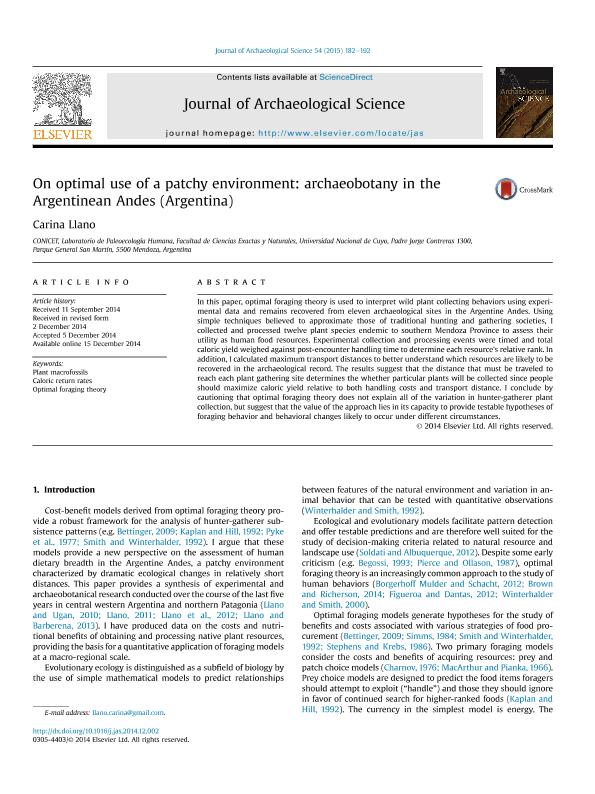Mostrar el registro sencillo del ítem
dc.contributor.author
Llano, Carina Lourdes

dc.date.available
2018-01-03T20:53:21Z
dc.date.issued
2014-12
dc.identifier.citation
On optimal use of a patchy environment: archaeobotany in the Argentinean Andes (Argentina); Elsevier; Journal of Archaeological Science; 54; 12-2014; 182-192
dc.identifier.issn
0305-4403
dc.identifier.uri
http://hdl.handle.net/11336/32230
dc.description.abstract
In this paper, optimal foraging theory is used to interpret wild plant collecting behaviors using experimental data and remains recovered from eleven archaeological sites in the Argentine Andes. Using simple techniques believed to approximate those of traditional hunting and gathering societies, I collected and processed twelve plant species endemic to southern Mendoza Province to assess their utility as human food resources. Experimental collection and processing events were timed and total caloric yield weighed against post-encounter handling time to determine each resource's relative rank. In addition, I calculated maximum transport distances to better understand which resources are likely to be recovered in the archaeological record. The results suggest that the distance that must be traveled to reach each plant gathering site determines the whether particular plants will be collected since people should maximize caloric yield relative to both handling costs and transport distance. I conclude by cautioning that optimal foraging theory does not explain all of the variation in hunter-gatherer plant collection, but suggest that the value of the approach lies in its capacity to provide testable hypotheses of foraging behavior and behavioral changes likely to occur under different circumstances.
dc.format
application/pdf
dc.language.iso
eng
dc.publisher
Elsevier

dc.rights
info:eu-repo/semantics/openAccess
dc.rights.uri
https://creativecommons.org/licenses/by-nc-sa/2.5/ar/
dc.subject
Archaeobotany
dc.subject
Optimal Foraging Theory
dc.subject
Wild Plant
dc.subject
Mendoza
dc.subject
Plant Macrofossils
dc.subject
Caloric Return Rates
dc.subject.classification
Historia

dc.subject.classification
Historia y Arqueología

dc.subject.classification
HUMANIDADES

dc.title
On optimal use of a patchy environment: archaeobotany in the Argentinean Andes (Argentina)
dc.type
info:eu-repo/semantics/article
dc.type
info:ar-repo/semantics/artículo
dc.type
info:eu-repo/semantics/publishedVersion
dc.date.updated
2018-01-03T19:58:27Z
dc.journal.volume
54
dc.journal.pagination
182-192
dc.journal.pais
Países Bajos

dc.journal.ciudad
Ámsterdam
dc.description.fil
Fil: Llano, Carina Lourdes. Universidad Nacional de Cuyo. Facultad de Ciencias Exactas y Naturales. Laboratorio de Paleoecologia Humana; Argentina. Consejo Nacional de Investigaciones Científicas y Técnicas. Centro Científico Tecnológico Conicet - Mendoza; Argentina
dc.journal.title
Journal of Archaeological Science

dc.relation.alternativeid
info:eu-repo/semantics/altIdentifier/doi/http://dx.doi.org/10.1016/j.jas.2014.12.002
dc.relation.alternativeid
info:eu-repo/semantics/altIdentifier/url/http://www.sciencedirect.com/science/article/pii/S0305440314004555
Archivos asociados
